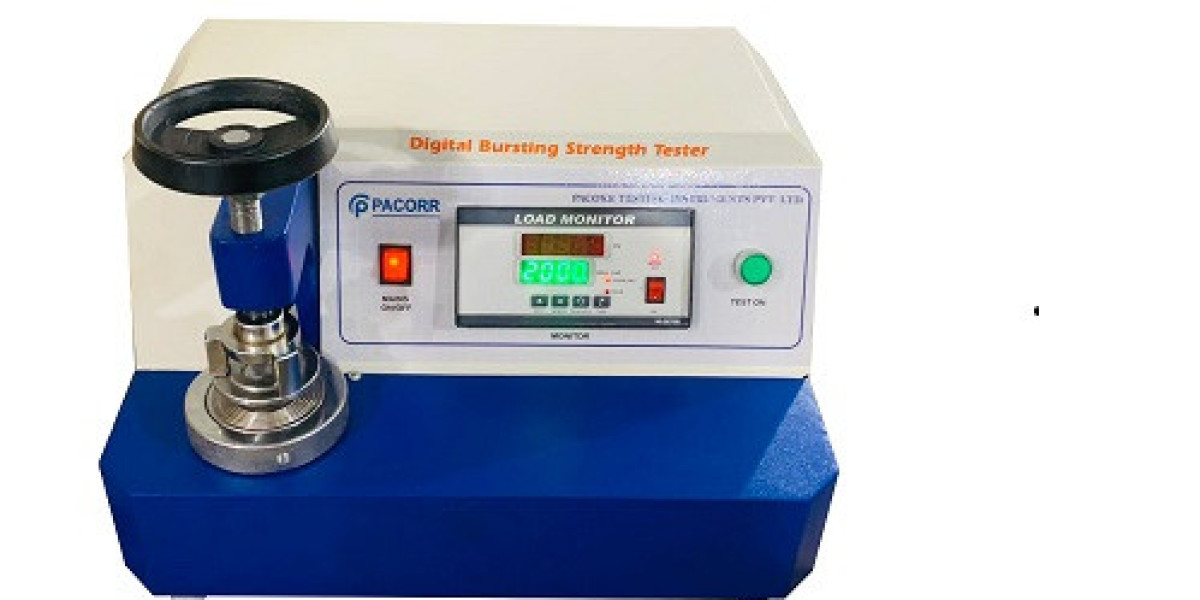What is a Bursting Strength Tester?
A Bursting Strength Tester is designed to measure the force required to rupture materials like paper, cardboard, textiles, and even polymers. By applying hydraulic or pneumatic pressure until the material fails, this tester provides critical data about the material’s strength and its ability to withstand stress.
Key Features and Specifications
· Digital Display: Modern testers come with a digital display, providing precise and easy-to-read results.
· High Precision: With a pressure range typically up to 40 Kg/cm² and a least count of 0.1 Kg/cm², these testers offer highly accurate measurements.
· Compliance with Standards: They adhere to international standards such as ASTM D3786, ASTM D774, and ISO 1060 PART-1 1987, ensuring consistent and reliable results across different laboratories and industries.
· Automatic Operation: Automated testing reduces human error and improves repeatability.
· Pneumatic Clamping: Some models feature pneumatic clamping for secure and slip-free holding of the specimen during testing.
Applications Across Industries
Packaging Industry
In the packaging sector, the strength of materials like corrugated boxes and cardboard is crucial. Bursting Strength Tester help ensure that packaging can withstand the pressures of shipping and handling, protecting the contents during transit. This is particularly important for e-commerce, where packaging integrity directly affects customer satisfaction
Paper Manufacturing
For paper products such as bags, envelopes, and sheets, bursting strength is a key indicator of quality. By testing the bursting strength, manufacturers can ensure that their products are durable and fit for purpose, reducing the risk of failure in real-world applications.
Textile Industry
In textiles, assessing fabric strength is vital for quality assurance. Bursting Strenght Testing evaluate how fabrics will perform under stress, ensuring that garments and other textile products can withstand wear and tear. This testing is also crucial for evaluating the strength of seams and the overall durability of finished products.
Polymer and Plastics
Though not all plastics are suited for bursting strength tests due to their elasticity, specific plastic materials that behave similarly to paper can be tested for their resistance to bursting under pressure. This ensures that products made from these materials are robust and reliable.
Benefits of Using Bursting Strength Tester
Quality Assurance: By identifying weak points in materials, manufacturers can ensure that only high-quality products reach the market, enhancing brand reputation and customer satisfaction.
Cost Efficiency: Early detection of material flaws reduces waste and lowers production costs by preventing the manufacture of defective products.
Regulatory Compliance: Adhering to ASTM and ISO standards ensures that businesses comply with international quality benchmarks, which is crucial for global trade.
Product Development: Understanding the Bursting Strenght Testing of materials aids in the design and engineering of products that are both durable and functional, leading to better consumer experiences.
Conclusion
The Bursting Strength Tester is a critical tool in the arsenal of quality assurance for packaging, paper, textiles, and polymers. Its ability to provide precise and reliable data on material strength ensures that products meet the highest standards of quality and durability, safeguarding both the integrity of the products and the satisfaction of end-users.
FAQs Bursting Strength Tester
1. What is a Bursting Strength Tester?
A Bursting Strength Tester measures the pressure required to rupture a material by applying hydraulic or pneumatic pressure until it bursts. This helps in determining the material's durability and structural integrity.
2. Why is bursting strength important?
Bursting strength is crucial as it directly relates to the material’s ability to withstand stress during shipping, handling, and use. It helps manufacturers ensure the quality and durability of their products.
3. What materials can be tested with a Bursting Strength Tester?
Materials such as paper, cardboard, textiles, and synthetic leathers can be tested using a Bursting Strength Tester.
4. How does a Bursting Strength Tester work?
The tester applies hydraulic or pneumatic pressure to a specimen until it bursts. The pressure required to cause the rupture is measured to determine the material's bursting strength.
5. What standards do Pacorr's Bursting Strength Tester comply with?
Pacorr’s Bursting Strength Tester comply with ASTM D 3786-01, ASTM D 3786-80A, and ISO 1060 PART-1 1987 standards, ensuring consistent and reliable testing results.
6. Can the Bursting Strength Tester be used for testing plastic materials?
While primarily designed for paper and paper-like materials, some models can test polymers and plastics under certain conditions.
7. What features should I look for in a Bursting Strength Tester?
Key features to consider include digital display, pneumatic clamping, microprocessor-based operations, compliance with international standards, and automatic features like sample clamping and data recording.
For more information, visit Pacorr.com








